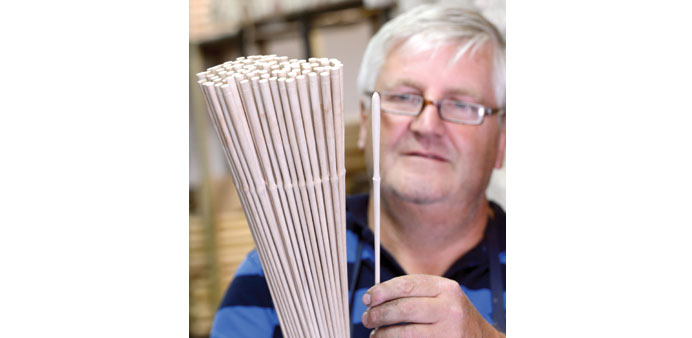By Tino Moritz
|
|
The great 20th-century conductor Arturo Toscanini had a habit of breaking his batons in frustration at the supposed incompetence of the orchestras he was working with.
That kind of temperamental behaviour would not go down well these days with a top-level orchestra. Nevertheless conductors’ batons remain in demand, and German company Rohema Percussion is there to fulfil that demand.
Founded in 1888, Rohema is now the oldest company in the baton-making sector, celebrating its 125th anniversary in the course of 2013.
The company, based in Markneukirchen in eastern Germany on the border with the Czech Republic, produces 20,000 batons every year, more than any other competitor, according to Matthias Hellinger, who heads the business.
Hellinger, 56, has little competition.
Apart from a few specialists who produce hand-made batons in the United States, Japan and India, there is no one in Europe at least possessing the equipment needed for serial production.
“Batons are not a lucrative business. Yields are low for the considerable effort involved,” Hellinger says, adding that special equipment is needed for the job. “And you have to know your market.”
His brother Andreas, who runs the business with him, is the only other person who understands all the steps, right from the beech wood delivered from a sawmill in Bavaria to the finished product.
“The wooden batons are really difficult to make.
“We receive the carbon fibre and fibreglass batons ready made and all we have to do is sharpen them a bit and paint them white. Then the basic form is complete in principle,” Hellinger says.
But this is not the end of the process. There are many types of baton, and Rohema has 70 different models in its range, differing with respect not only to material and length but also grip.
“Every director has his personal preference, and in recent years, balanced batons have come to dominate,” he says. For this the fibreglass models, which are about three times the weight of the wood, need a brass ring.
“When the conductor has been conducting for two hours, he occasionally opens his hand to relax it, and if the baton is not balanced, it falls out of his hand.”
The simple models are produced at a rate of up to 30 an hour, while more complicated individual orders can take much longer. Batons may be had in the retail outlet for around $3.50. “But for us these make up just 5 to 10% of turnover,” says Hellinger’s son Maik, who plans to take the family business into the fifth generation along with his cousin.
While Rohema is proud of its commissions from conductors with names like Zubin Mehta and Daniel Barenboim, batons are far from being its only business.
The company is also known for its drumsticks and wooden percussion instruments for children.
Barenboim has had his batons made in Markneukirchen since the end of the 1990s. “He wanted something special and came to us,” Hellinger says, adding that the conductor goes through 20 to 40 batons a year. “They are 43cm long and painted white.”
He would like to use the famous conductor’s name for the model, but has been unable to make contact with him to gain permission. Hellinger’s grandfather started the tradition of naming particular models after the conductors that used them in the 1930s, and the company still has the Vivaldi, at 355mm, and the Smetana at 370 in its range.
There is also the Mozart and the Handel, each 430mm in length, and the Strauss at 465mm.
The firm’s 1927 catalogue reveals conducting batons made of ebony with carved ivory tips and named after the likes of Beethoven and Wagner, but these were items for display rather than use and were extremely pricey.
Hellinger is keen to dispel a myth generated by pictures and films, in which the conductor is frequently seen with a black baton. “That’s rubbish,” he says.
The musicians, often sitting in half light, need to see the conductor’s rapid movements with the little stick after all. “It’s not a magic wand,” he says. — DPA

